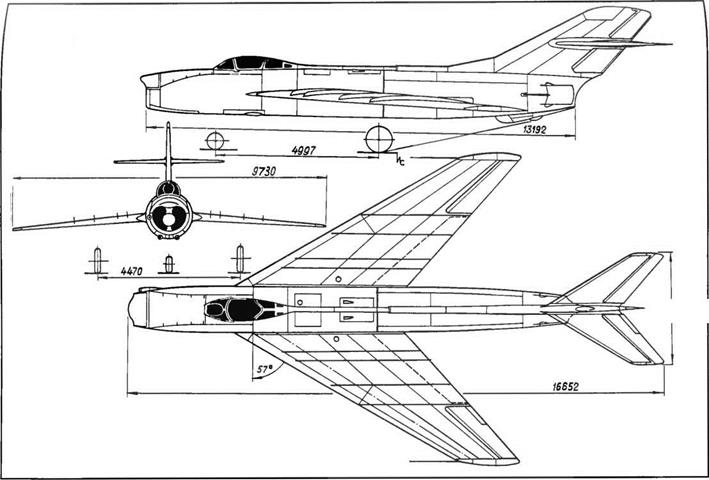1-350 / M
In 1947 A. M. Lyulka, a renowned engine specialist, began to develop a new turbojet that would produce a thrust of 4,410 daN (4,500 kg st). It was the VRD-5, later called the TR-3. This engine, based on a seven – stage axial compressor, was developed years later and built as the AL-5 and then the AL-7 with thrust limited at first to 5,095 daN (5,200 kg st). But in the late 1940s the only engine available to power the new MiG supersonic fighter was the TR-3A. The program was officially launched by a decree of the council of ministers on 10 June 1950.
The 1-350—known at MiG as the M project—was a single-engine, all-metal, midwing fighter. The wing sweep at the leading edge was 60 degrees, and the wing aspect ratio was 8.6. The wing had been designed at TsAGI by a team of aerodynamicists managed by V. S. Stru – minski and G. S. Byushgens. The M was equipped with an RP-1 Izum – rud radar whose antennae were housed in the upper lip and partition
|

of the air intake, just like the MiG-17P, M1G-17PF, and MiG-17PFU The M wing had eight fences on the upper surface Under the rear part of the fuselage was a small ventral fin with a bumper, and the nozzle throat was flanked by two airbrakes The 1-350 was the first MiG fighter to be fitted with a tail chute Armament was identical to that of the MiG-15 and the MiG-17- one N-37D and two NR-23 cannons mounted on a removable tray
The flight tests were conducted by G. A Sedov, and the first flight took place on 16 June 1951. This flight nearly ended in disaster as Sedov throttled back to prepare to land the TR-3A shut down abruptly at an altitude of only 2 000 m (6,560 feet) Only the sangfroid, experience, and decisiveness of the pilot could save the aircraft The engine shutdown caused a pressure drop in the hydraulic system, and the stick force increased suddenly. When Sedov tried to extend the gear with the usual hydraulically controlled lever, the right mam gear strut refused to extend The ground staff immediately notified Sedov over the radio, but the aircraft was now only 20 to 30 meters off the ground At the last second Sedov actuated the emergency gear lever, which was pneumatically controlled Eyewitnesses reported that the gear strut snapped into place just as the wheel touched the runway
This first flight lasted nine minutes and ended m what was probably the first power-off landing for a supersonic fighter in the USSR. If Sedov had used the occasion to demonstrate his prowess, the TR-3A (AL-5) had proved that it was not nearly reliable enough to power a single-engine fighter Six more flights took place before development efforts were abandoned If the 1-350 (M) program had continued, two other versions would have appeared the M-2, equipped with Korshun radar, and the MT a tandem-seat trainer
Specifications
Span, 9 73 m (31 ft 11 in) overall length 16 652 m (57 ft 7.6 in), fuselage length, 13,192 m (43 ft 3.4 in), wheel track, 4 47 m (14 ft 8 in); wheel base, 4 997 m (16 ft 7 in), wing area, 36 m2 (387 5 sq ft), empty weight, 6,125 kg (13,500 lb); takeoff weight, 8,000 kg (17,630 lb), max takeoff weight, 8,710 kg (19,197 lb); wing loading, 222 2-241 9 kg/mz (45 5-49 6 Ib/sq ft)
Performance
Max speed, 1,266 km/h at 10,000 m (684 kt at 32,800 ft), max speed at sea level, 1,240 km/h (670 kt), climb to 5,000 m (16,400 ft) in 11 min, to 10,000 m (32,800 ft) in 2 6 min, service ceiling, 16 600 m (54,450 ft); range, 1,120 km (695 mi), range with 800-1 (211-US gal) drop tank. 1,620 km (1,006 mi)










